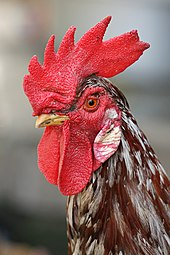Sex characteristic
Sexual characteristics are the characteristics that are differently pronounced between the sexes of an animal species . There are primary , secondary and tertiary sex characteristics.
Primary Sexual Characteristics

Primary sexual characteristics are the sexual organs , which are primarily used for direct reproduction, such as B. vulva , vagina , ovaries , uterus , testes , epididymis , seminal ducts and penis . They are already present at birth in mammals and humans.
Secondary sexual characteristics

Secondary sexual characteristics are physical characteristics that are not directly necessary for sexual reproduction . They develop through sexual maturity . In humans, these are the female breast and the male beard . An example in animals is the cockscomb .
Secondary sexual characteristics are physical characteristics that can be changed over the generations through sexual selection . For example, they often increase attractiveness towards the other or one's own gender or assertiveness towards competitors or serve to raise the young. Often they affect the feather and coat, teeth and skeletal features, but also horn and antler formation , mammary glands or the pouch of marsupials . In many living things, the secondary sexual characteristics that develop with sexual maturity are permanent; other species only show sexual dimorphism at mating season. Secondary sexual characteristics are often also related to reproductive function , as the formation of a birth canal , for example , leads to changes in the body structure (see anatomy of the pelvis and the birth dilemma ).
Tertiary sexual characteristics
Tertiary sexual characteristics are other sexual characteristics. They sometimes develop with sexual maturity, such as the darker color of the males of the catfish or the bone structure in the form of a female or male pelvis or the body size. The demarcation of the physical characteristics between secondary and tertiary gender characteristics is not always clear, since the environment as well as genetics play a decisive role. Behavioral, psychological and social characteristics belong to the tertiary gender characteristics and are often not hereditary, but learned.
Web links
Individual evidence
- ^ A b Wolfgang Clauss, Cornelia Clauss: Humanbiologie compact . Springer, 2009, p. 348.
- ↑ a b c Pschyrembel: Clinical Dictionary . 256th edition. De Gruyter.
- ↑ Sexing Chicks After a Few Weeks. ( Memento from January 21, 2013 in the Internet Archive )
- ^ Krist West: Animal Courtship. Chelsea House Pubs, 2009, p. 26.
- ^ The American heritage science dictionary. Houghton Mifflin, 2005, p. 558.
- ^ Rüdiger Wehner, Walter Gehring: Zoologie. 23rd edition. Thieme Verlag, 1995.
- ^ Robert G. Piper: Fish Hatchery Management . Forgotten Books, 2010, p. 138.
- ↑ http://www.spektrum.de/lexikon/biologie/geschlechtsmerkmale/27696
- ↑ Stefan Leitner: Genes and Environment: How Do They Influence Behavior and Physiology in Songbirds? Research report 2014 - Max Planck Institute for Ornithology.
- ↑ Bernhard Rensch: The phylogenetic special position of humans. 1957, page 33.
